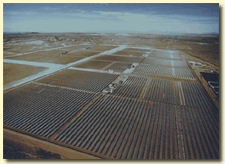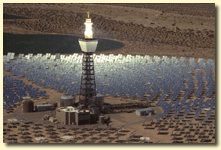DOE's
CSP Program
|

354
MW of SEGS plants continue to operate successfully on the California
power grid. Annual output of the plants has increased by 35% as plant
operations have improved over the past 10 years, and O&M costs have
correspondingly dropped 40%. These plants have demonstrated the ability
of CSP to meet utility requirements. Several domestic and international
projects are currently being planned.
|
BIG
Solutions for BIG Problems…
Concentrating
Solar Power
Recent electricity and gas shortages in
California and other western states, along with an expanding recognition of
environmental issues, have highlighted the need for clean, large-scale renewable
power. Because of its low cost, ability to deliver power during periods of peak
demand, and capability for large-scale and distributed deployment in the
near-term, Concentrating Solar Power (CSP) can be a major contributor to solving
our nation’s energy problems now and in the future.
CSP
is...
…proven,
reliable technology.
354 MW (enough for 100,000 homes) of concentrating solar power systems have
operated successfully in the Southern California desert for the past decade.
These Solar Electric Generating System (SEGS) plants consistently operate as
well as or better than when they were new.
…dispatchable.
CSP plants with cost-effective storage or natural gas hybridization can deliver
power to the utility grid when that power is most needed, not just when the sun
is shining. The SEGS plants peaking capacity routinely approaches 100%.
|

Solar
Two successfully demonstrated the power tower concept, including the
capability to store energy economically for dispatch at periods of peak
demand. U. S. industry is building the first commercial power tower
using this technology in Spain and simultaneously investigating
near-term opportunities in the U. S.
|
…competitively
priced solar power.
These existing CSP plants produce power now for as low as 12¢/kWh (including
both capital and operating costs), with costs dropping to as low as 5¢/kWh
within ten years as technology refinements and economies of scale are
implemented. Independent assessments by the World Bank, ADLittle, EPRI, and
others have confirmed these cost projections. While not currently the lowest
cost electricity, CSP is already close to competitive in peaking markets, and
there is significant demand for carbon-free electricity from green sources, even
at above market prices, where utility customers have the option of choosing
their energy supplier.
|

Solar
dish systems are the most efficient solar systems in the world. They
provide economical power for utility line support, distributed, and
remote applications, and are capable of fully autonomous operation.
Sized between 10 and 25 kW per dish, systems can be deployed
individually for water pumping or village power applications or grouped
to form megawatt-scale power plants.
|
…clean
and environmentally friendly.
CSP plants produce no emissions during solar electricity generation. While
hybrid plants like SEGS do burn gas during hybrid operations (for a maximum of
25% of their power), newer CSP technologies incorporating storage have the same
dispatchability with no fossil fuel usage and zero emissions.
…a near-term solution.
135 MW of new international CSP capacity is currently under design (supported in
part by the World Bank/GEF and Spanish solar premiums), while U. S. industry is
simultaneously pursuing a 200 MW CSP power park in the southwest U. S. Because
CSP uses relatively conventional technologies and materials (glass, concrete,
steel, and standard utility-scale turbines), production capacity can be scaled
up to several hundred megawatts/year rapidly, using existing industrial
infrastructure.
Big
Solutions for Big Problems... Concentrating Solar Power
Path 1: Distributed
Power
Path 2: Dispatchable
Power
Path 3: Advanced
Components and Systems
For
more information, see:
CSP
Five-Year Program Plan (1998-2003)
CSP
Twenty-Year Strategic Plan (1996-2015)
ADLittle
Teagan Review of CSP
Morse
Associates Review of CSP
DOE CSP
Program Peer Review 2001


